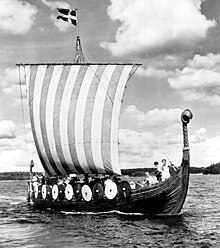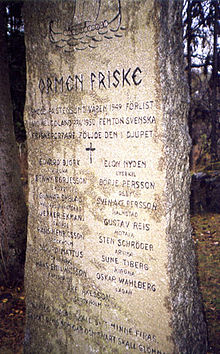Ormen Friske (ship)
The Ormen Friske ("strong / healthy snake") was a 1949 Swedish replica of the Norwegian Gokstad ship , a Viking ship from the 9th century . The ship broke apart on June 22, 1950 in heavy seas off Heligoland , with all 15 crew members perishing. Wreckage and nine bodies washed up on the North Frisian Islands and the coast of Jutland . The cause of the accident was not finally clarified.
construction
Like its historical model, the Ormen Friske was about 23 meters long and about five meters wide amidships. It was built in the spring of 1949 in the training center of the Svenska Frisksportförbundet cultural and sports club in Stensund near Trosa on the Baltic Sea and launched in June of the same year after only about six weeks of construction. Project manager and initiator was Sten Schröder, a board member of the association. The construction management was carried out by the shipbuilder Bror Westerlund, and the sailing ship expert Sam Svensson served as a consultant. After a transfer trip to Stockholm , where the ship could be seen as an exhibit in a sports exhibition, Schröder organized numerous demonstration trips, some for a fee, with which he wanted to earn the construction costs. However, the income generated was low.
Downfall
When, in the summer of 1949, a Danish replica of the Gokstad ship, the Hugin , aroused great media interest on its voyage to England , Schröder agreed with the organizers of the seafaring fair in Rotterdam that the Ormen Friske should appear there at the 1950 fair. On June 4, 1950, the ship cast off in the Viking trading center Birka on Lake Mälaren . Schröder was the oldest participant of the trip at 38 years of age, most of the crew members who were recruited from Frisksportförbundet members were between 20 and 25 years old. The ship reached the Baltic Sea through the Södertälje Canal. After eight days in adverse winds and rough seas, it reached Ystad , where repairs were made to the steering and rigging and the equipment was added. The Ormen Friske crossed the Baltic Sea from Ystad . After crossing the Kiel Canal , she reached the German Bight on June 21 . On June 22nd, the ship got caught in a severe storm in the North Sea and broke apart. All 15 people on board drowned. Corpses and wreckage were washed up as far as the North Frisian coast and Jutland .
The tragedy only became known four days after the storm: The Pellworm fisherman Nickels Liermann found on June 25th. between Norderoog and Süderoog the nine-meter-long stern of the ship and towed it to Pellworm. The island's telephone line was already closed. The next morning, he informed the authorities of his find. Gradually, the bodies of 9 of the 15 crew members were found and transferred to Sweden.
The first memorial for the Ormen Friske crew was erected on Pellworm. The memorial stone by the tower of the old church was unveiled at Easter 1951 with the participation of the Swedish consul, a clergyman from the Swedish community of Hamburg and the Bishop of Schleswig. A copy of the Pellworm memorial stone is in the Kalmar cemetery , where the father of one of the victims was pastor.
Root cause research
Although numerous, even larger parts of the wreckage of the Ormen Friske could be recovered, no detailed research into the cause of the accident took place.
- Construction flaw (weak point on the keel); accordingly, unsuitable building materials have been used ( keel made of multiple glued pine boards with smooth butt joints without sufficient joint spacing instead of hewn oak beams as in the historical model); These weak points could have caused the keel pig to break and, as a result, to the ship breaking apart, even at low loads amidships; Braun quotes with reference to the Swedish magazine " Teknikens Värld ", No. 13, 1950, pp. 8–9 and 31, a Danish shipbuilder, according to which the Ormen Friske was more of a theatrical setting than a seaworthy ship and had significant structural defects.
literature
- Rune Edberg: Vikingaskeppet Ormen Friskes undergång: ett drama i det kalla krigets skugga. (= Södertörn archaeological studies, Volume 2). Runius & Co, Huddinge 2004, ISBN 91-628-5977-3 . (With a German summary (pp. 259–264) and numerous photos)
Web links
- Martin Braun: The sinking of the Ormen Friske cleared up after 54 years: Construction and construction errors in the Kiel were a death sentence even in light seas.
Individual evidence
- ↑ Thorsten Ahlf: The dangerous history of the Viking replicas. Hamburger Abendblatt, August 17, 2007, accessed on June 9, 2015 .
- ↑ a b c d Rune Edberg: Rune Edberg: In the Wake of a Viking Ship Tragedy. An Archaeologist's Challenge to a Cold War Cover-up. Journal of Archeology and Ancient History (Uppsala Universitet), 2013, accessed June 9, 2015 .
- ↑ Graphic: Ormen Friske's route (Author: Rune Edberg) [1]
- ^ Rune Edberg: Vikingaskeppet Ormen Friskes undergång: ett drama i det kalla krigets skugga. (Södertörn archaeological studies, Volume 2). Runius & Co, Huddinge 2004, ISBN 91-628-5977-3 , p. 107.
- ^ "Ormen Friske" memorial stone. Hamburger Abendblatt, March 27, 1951, accessed on June 9, 2015 .
- ^ Rune Edberg: Vikingaskeppet Ormen Friskes undergång: ett drama i det kalla krigets skugga. (Södertörn archaeological studies, Volume 2). Runius & Co, Huddinge 2004, ISBN 91-628-5977-3 , p. 203.
- ↑ Martin Braun: The sinking of the Ormen Friske cleared up after 54 years: Design and construction errors in the keel were a death sentence even in light seas.
- ↑ [2]


